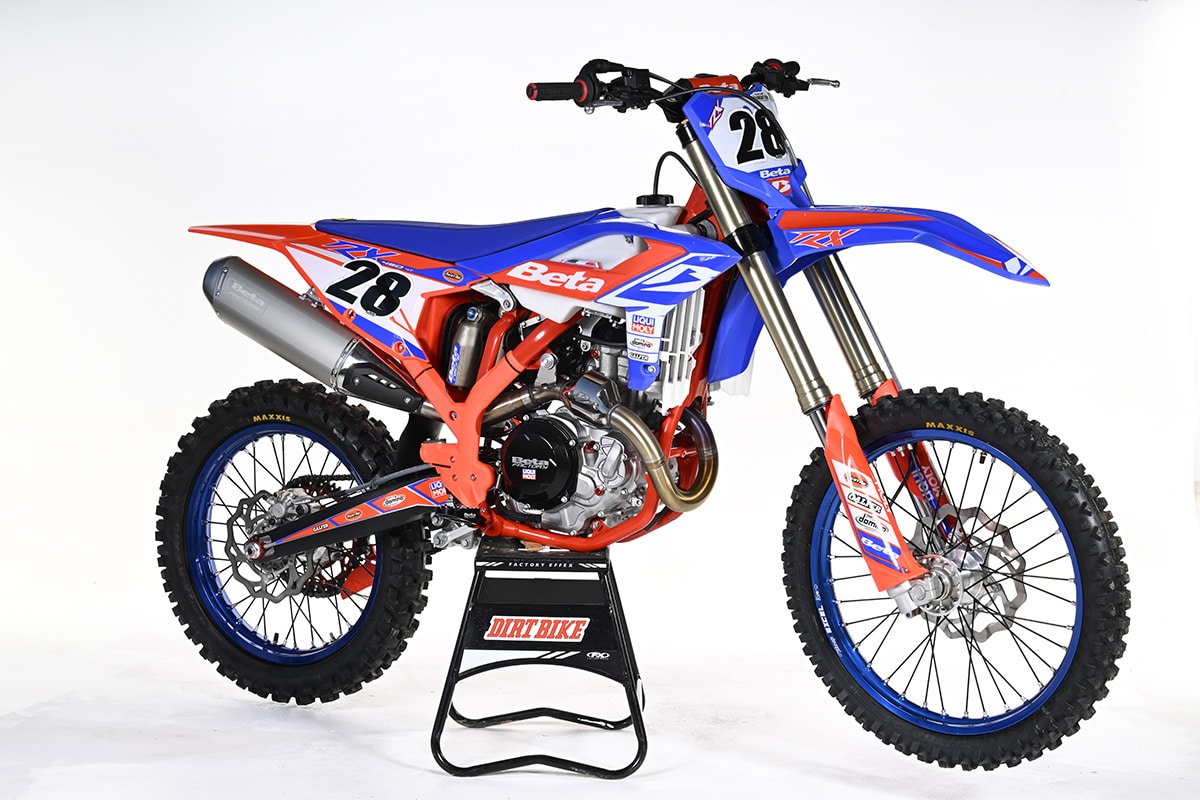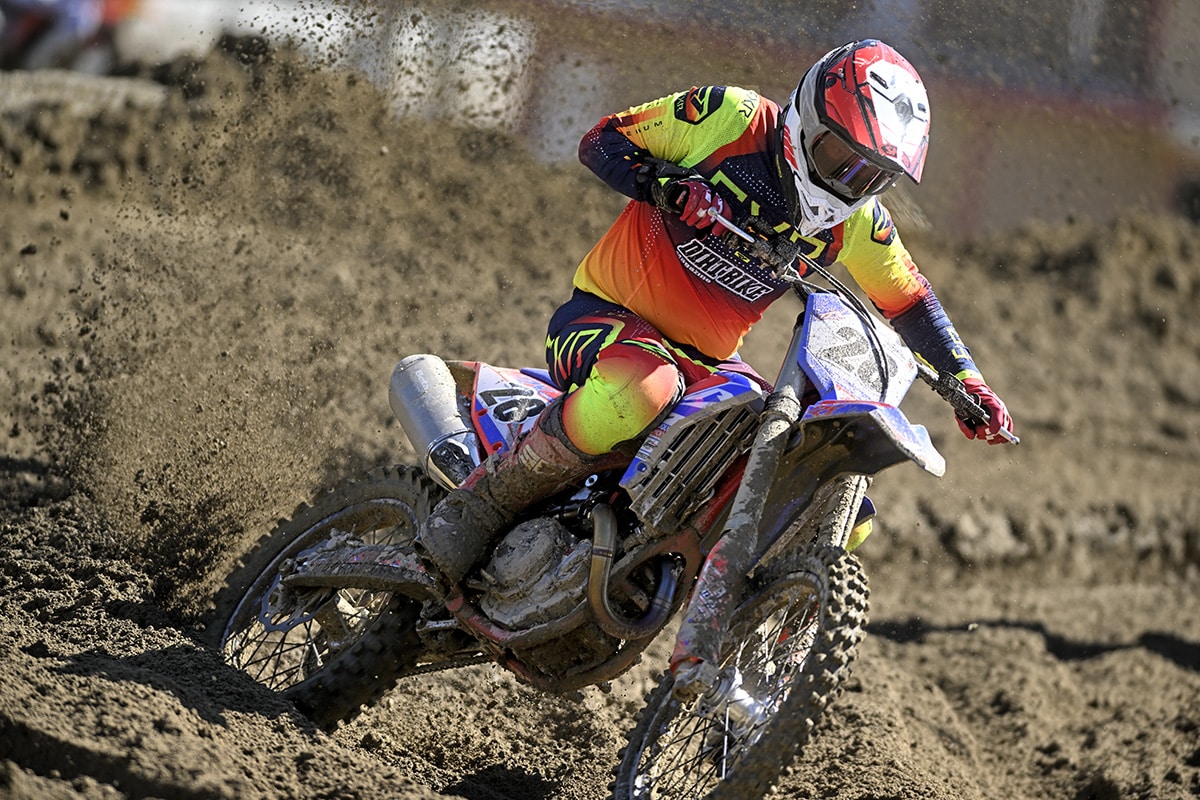It’s about time. We’re surprised that anyone is surprised by Beta’s entry into the motocross world. This is a company that knows how to build race bikes; that much is obvious from a long list of championships that includes World Enduro, EnduroCross, Hare & Hound and, of course, trials. The real surprise is, what took so long?
The 2024 Beta 450RX is here now, following in the footsteps of the 300RX two-stroke, which was released in 2021. The four-stroke has three years of development in MXGP racing and has attracted the attention of moto-centric press that previously never noticed Beta and still can’t figure out how to pronounce the name. We think it’s a little funny. We’ve always known that this is a small company that routinely goes toe to toe with the giants of the motorcycle world.

ALL NEW IN THEORY
Beta says that the 450RX is all new. That’s technically true from a standpoint of many part numbers, but it’s clear that Beta didn’t start from scratch. The motor is based on the 430RR off-road bike. The bore is larger, the crank is lighter, the compression ratio is increased, the gearbox is a 5-speed instead of a 6-speed, and it has a larger throttle body. The exhaust system is completely different, too, but the overall architecture of the motor is the same. It’s a wet-sump motor with separate chambers for the engine and gearbox oil. There are two oil pumps, and the valve train uses double-overhead cams driving four valves through finger-followers. The only outward difference between the RX and the RR is the lack of a kick-starter mounting location. Even the clutch is the same aside from the RX’s stiffer Belleville spring.

It’s a similar story with the chassis. The overall description is still a steel frame with a central backbone. The geometry doesn’t stray far from what has worked for Beta’s off-road bikes. For the RX, however, the backbone is larger and has an aluminum subframe. The suspension consists of a closed-cartridge KYB fork and a piggyback KYB shock with triple adjusters. Those are the same components that are used on the RR Race Editions, but the valving and spring rates are all stiffer for motocross. The linkage is the same across all of Beta’s four-strokes, and so is the top triple clamp.
The brakes are Nissin, the clutch hydraulics are Brembo, and all of the individual components look like premium-quality aftermarket parts. That includes aluminum footpegs, a bi-metal rear sprocket and a whole bunch of anodized parts. The tires are Maxxis. In dry weight, the 450RX is considerably lighter than its off-road cousins. It weighs 237 pounds without fuel on our scale. That’s lighter than a Kawasaki or Suzuki, and heavier than a KTM, Honda or Yamaha.


AN OLD FRIEND
If you’re familiar with Beta’s offroad bikes, you’ll know exactly what to expect here. The 450RX wears its heritage right out front. It’s a large bike with excellent stability and flawless manners. It is, of course, much more powerful than any Beta we’ve ridden in the past, but the overall temperament of the motor is still smooth and friendly. By the standards of most 450 motocross bikes, it’s a real sweetheart. The usable torque starts much lower than other 450s and has a very gradual progression. All the excitement comes in the middle. There, the Beta is right in the hunt with any 450 on the track. On top, it doesn’t have as much peak as a Yamaha or KTM, but it does have good over-rev. The Beta doesn’t stop in its tracks like many motocross bikes when the revs get really high. It misses a little, and the power output tapers off, but if you’re in a drag race to the next turn, you can stretch each gear if you have to. Overall, the motor is most like a Kawasaki or Suzuki. In our opinion, that’s excellent company.

On the handlebar pad, there are switches that give you a choice between two different EFI maps and traction control. The setting with a rain-cloud emoji smooths out the hit in the middle without altering the low-end power. Overall, many riders felt the power delivery was already a little too smooth, so it was left on the sunshine emoji even when our test days were wet and soggy. Same goes for traction control. You also get three different throttle cams when you buy the bike. These are a very effective way of altering the throttle response for various conditions.
As we mentioned, the Beta is a large motorcycle. That’s good and bad. For tall riders, it’s a bonus to have a roomy, spread-out riding position. For shorter pilots, the seat height is excessive. It’s at least as tall as a current Yamaha YZ450F, maybe taller. The seat itself is also very thin and hard, so there’s not much room to give up there.

In the suspension department, Beta might be exploring new territory in the motocross world, but they clearly had some help from KYB. It’s already in the hunt. It is much, much stiffer than anything else in the company’s lineup, but still a little soft by MX standards. That isn’t to say it dives or is mushy. On the contrary, the fork has excellent holdup on braking and in G-outs. It’s only when you get into really rough terrain that it uses up its travel quickly. The rear end is a little more consistent. It might be on the soft side for an aggressive pro rider, but rank-and-file sportsmen will find it about right.

OFF-ROAD CROSSOVER
Beta has clearly identified its priorities in its “Rideability” campaign slogan. Normally, we don’t pay too much attention to such things, but in this case, it’s for real. That’s what the RX is all about. The power and the suspension are on the soft side, the chassis is stable, and nothing wicked ever happens. It’s one of those rare bikes that lets you know exactly what it’s going to do well ahead of time. To us, it’s just like the off-road Betas that we know so well, only faster. That’s very good news for riders in western-style GPs, like NGPC and WORCS. The RX will be perfect for them, as well as the greater majority of sportsmen-level motocross riders. Does that mean it’s too tame for high-level pros? In some cases that might be the case, but there’s clearly a Colt Nichols-level bike in there. And, we know that it’s easier to make a pleasant bike stiff and aggressive than it is to bolt on a good personality. That’s something that has to be in there from the start.



Comments are closed.